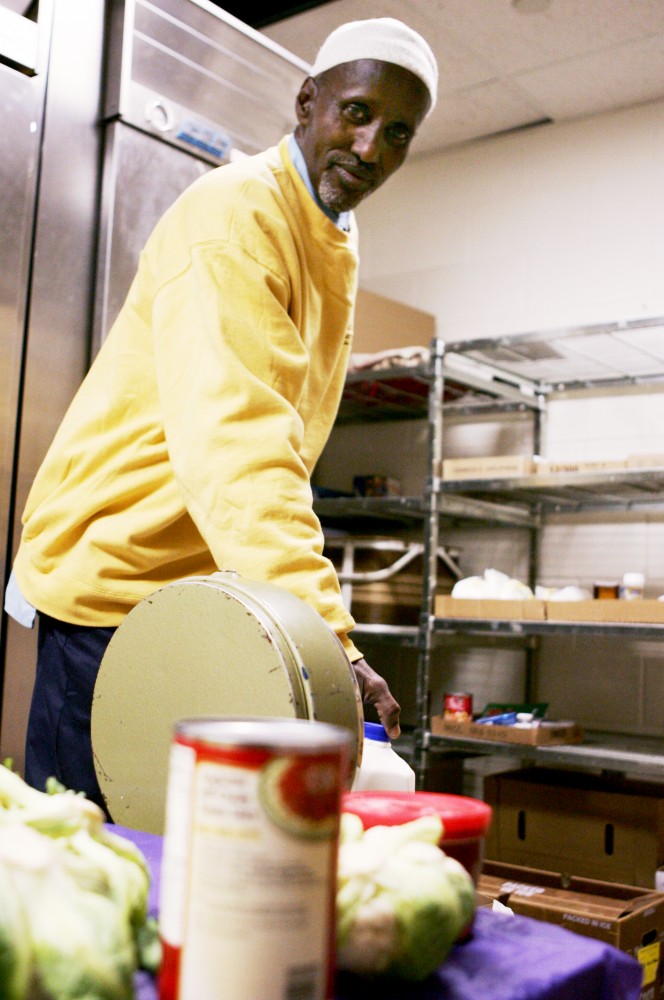At the end of a long hallway at the Brian Coyle Community Center in MinneapolisâÄô Cedar-Riverside neighborhood, a small room is lined with shelves and a commercial refrigerator. On the shelves, cans of lima beans sit aside boxes of macâÄônâÄôcheese and plastic bags of East Indian spices. Every day when the food shelf closes, the metal shelves are bare. The next morning, workers restock them again from a diminishing supply across the hallway. Food shelves have seen a 14 percent increase in visits during the first half of 2008, according to data from Hunger Solutions Minnesota, a statewide hunger relief agency. Since July, when Becky Burand took over responsibility for the Brian Coyle food shelf, sheâÄôs seen monthly increases in demand. âÄúSeptember was something like 300 people, October was 400,âÄù she said. âÄúWe are seeing two or three new families every day.âÄù At the same time as demand has increased, donations of money and food to food shelves have slackened, she said. âÄúItâÄôs mostly middle-class people who donate, itâÄôs not the people with tons of money who are giving money to food shelves.âÄù she said. âÄúItâÄôs also the middle class thatâÄôs really suffering right now.âÄù Each visitor to the Brian Coyle food shelf, which serves the predominately East African neighborhood, is typically allowed 15 pounds of food per month. âÄú[That] works for individuals, but thereâÄôs quite a few families of seven, eight, 10, who donâÄôt end up with their total pounds of food just because we donâÄôt have the capacity to give them that a month,âÄù Burand said. Paullette Meyers , a Riverside Plaza resident who visited the food shelf Tuesday, said she has noticed the increased demand. âÄúEvery time I do come,âÄù she said, âÄúit seems like itâÄôs halfway depleted of things that are worthwhile in coming and getting.âÄù Meyers said the food shelf allows her to tide herself over until other food or money sources arise. âÄúI appreciate the fact of being able to come here and to get what little I can get,âÄù she said. âÄúYou have to be thankful for what youâÄôve got.âÄù Meyers took out her full monthly allotment from the food shelf Tuesday. âÄúNot having any money for food, [IâÄôm] down to my last, very last,âÄù she said. âÄúAfter this I donâÄôt know where IâÄôll get food from.âÄù Jill Hiebert , communications manager for Hunger Solutions, said increases in demand can be attributed to rising unemployment and increased food costs. âÄúYour dollar goes a lot less far in the grocery store,âÄù she said. âÄúOnce that flexible part of your budget is run out, then you can turn to food shelves.âÄù Between 2000 and 2007, food shelves in Minnesota saw demand increase by 67 percent, Hiebert said. âÄúAll indication is, as we speak to food shelves, that more people are coming in,âÄù she said. âÄúIn some cases theyâÄôre getting less food because the food shelves have access to less.âÄù Hunger relief is a popular focus around the holidays, Burand said, but for every dollar donated to a food shelf, the food shelf can purchase around $10 worth of food. âÄúWhile food drives are great and itâÄôs a wonderful way to make a difference in the community,âÄù she said, âÄúfinancial contributions really allow us to stretch our dollars.âÄù According to information collected by the U.S Department of Agriculture, almost 10 percent of Minnesotans struggle with hunger. Cutting across demographic lines, more than 47 percent of households visiting food banks had at least one person employed, while at least half had children, according to a 2006 study by Second Harvest Heartland , a regional food bank. These households often struggle with the decision of whether to buy food or pay other basic needs like rent or medical bills, according to the report. The downturn in the economy, Burand said, has forced many middle-class people to make similarly difficult decisions about how to feed their families. âÄúA lot of people are needing to turn to food shelves to make ends meet,âÄù Burand said. âÄúPeople who used to donate to us are now the ones coming in and using the food shelves.âÄù
Daily Email Edition
Get MN Daily NEWS delivered to your inbox Monday through Friday!

Published July 25, 2024

Published July 25, 2024

Published July 25, 2024
Trending
Food shelves lay bare

Image by Paul Bangasser
Tentacle Boy
Published November 25, 2008
Leave a Comment
More to Discover













